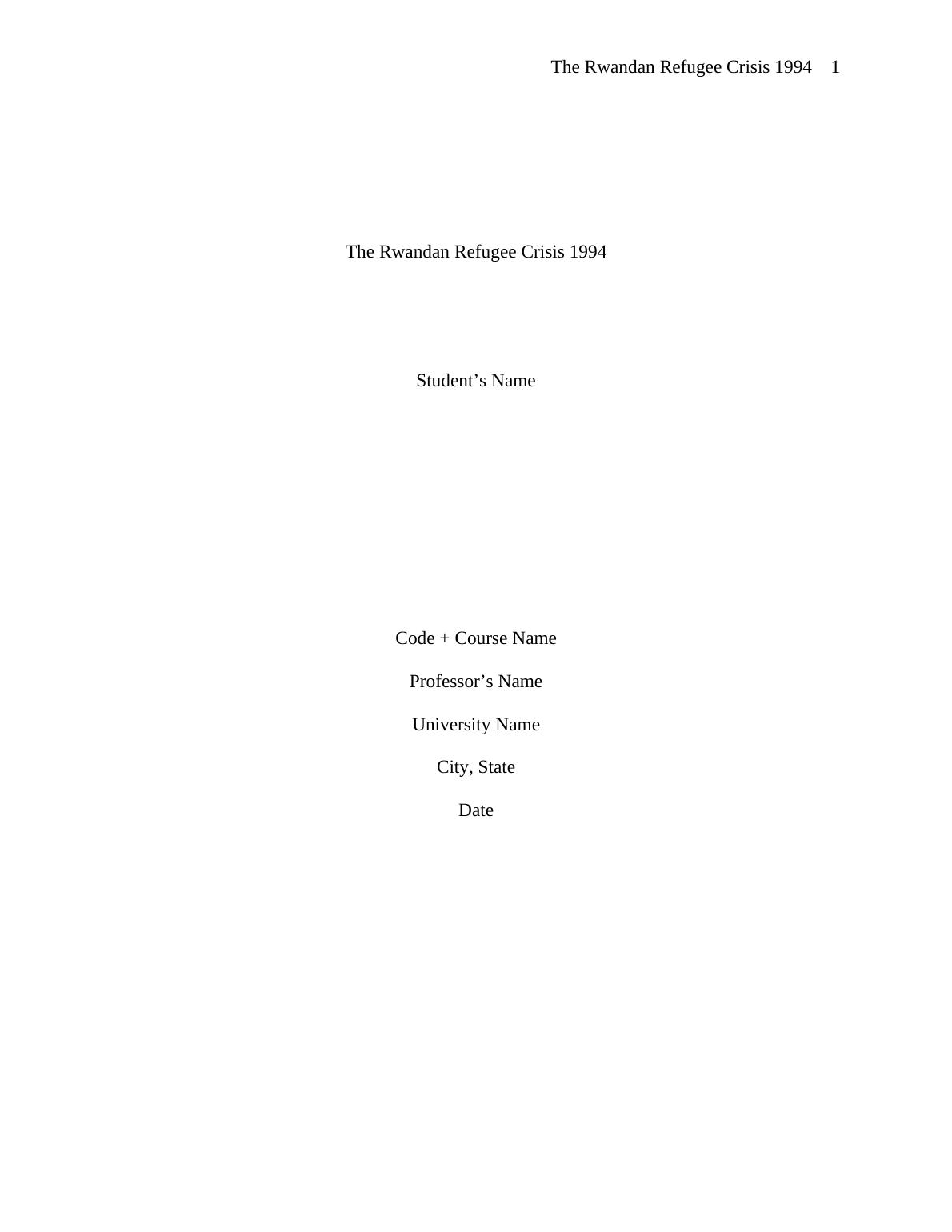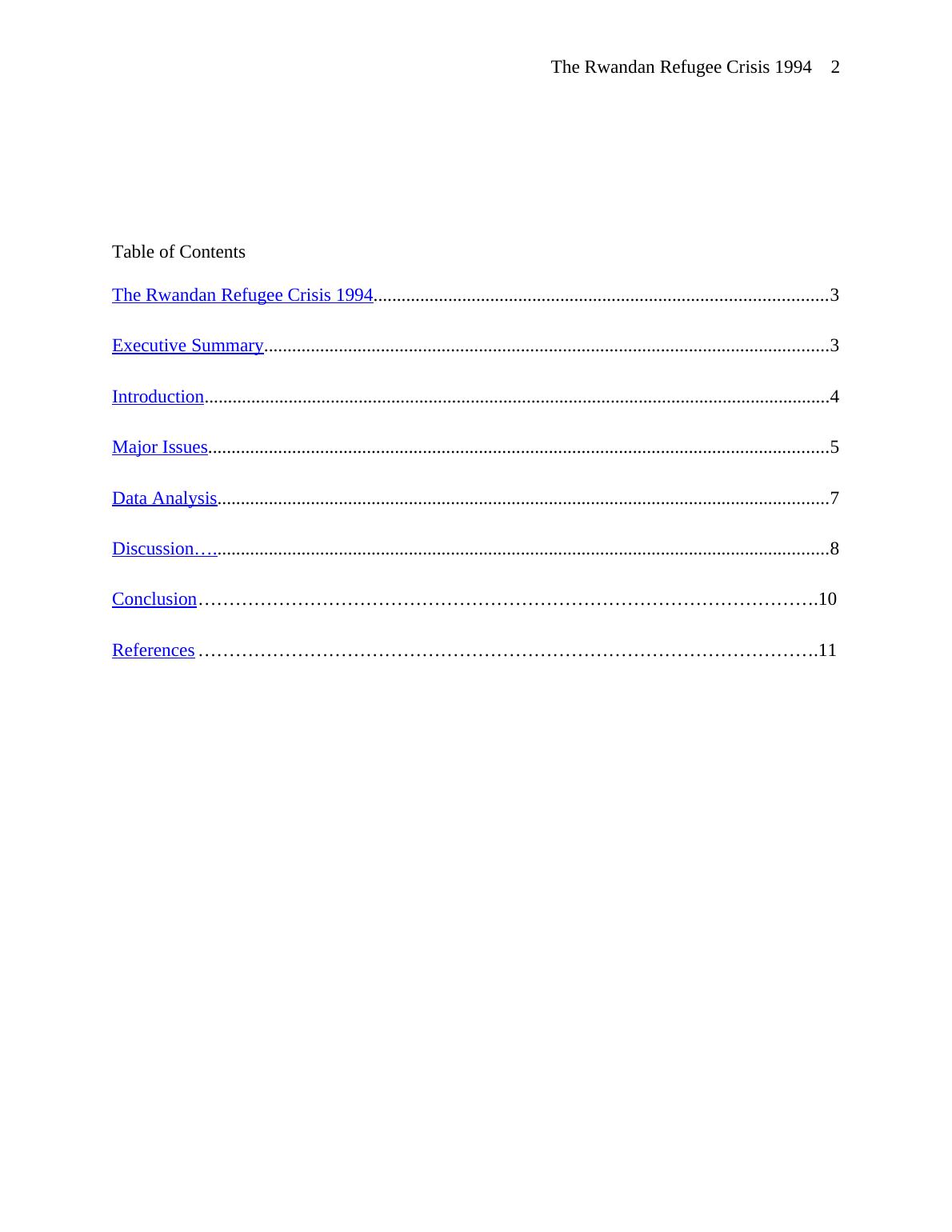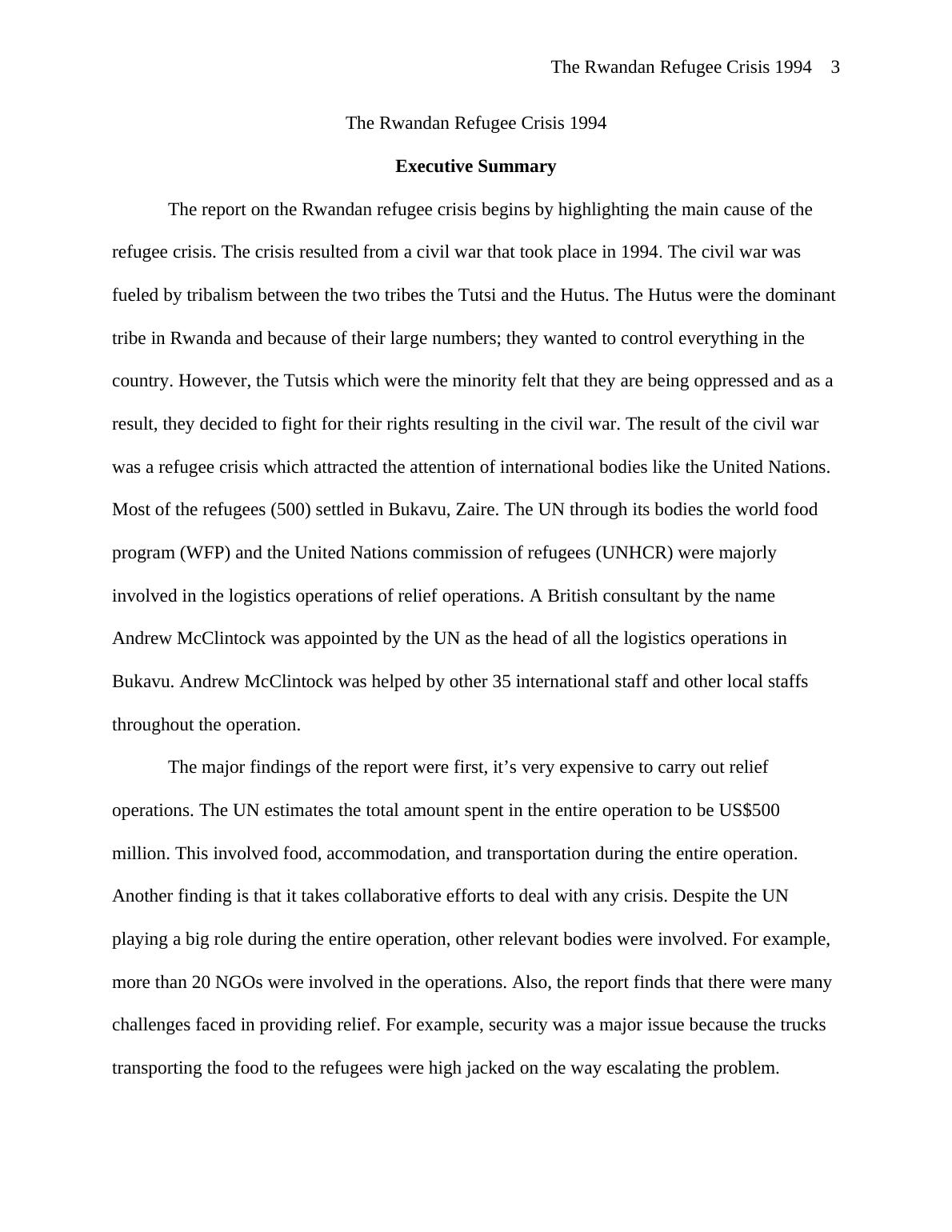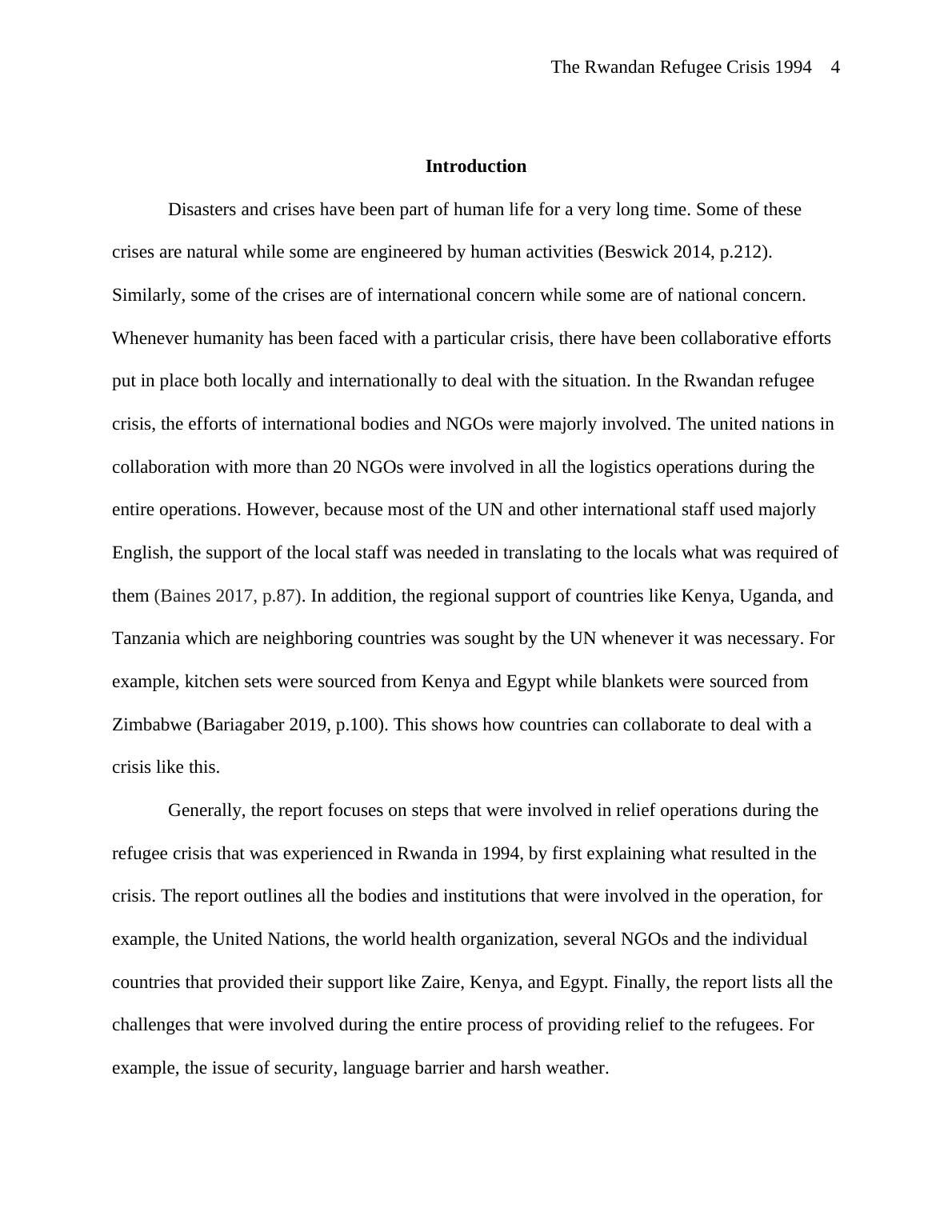The Rwandan Refugee Crisis 1994: Causes, International Operations, and Supply Chain Management
Added on 2022-11-18
12 Pages3457 Words125 Views
The Rwandan Refugee Crisis 1994 1
The Rwandan Refugee Crisis 1994
Student’s Name
Code + Course Name
Professor’s Name
University Name
City, State
Date
The Rwandan Refugee Crisis 1994
Student’s Name
Code + Course Name
Professor’s Name
University Name
City, State
Date

The Rwandan Refugee Crisis 1994 2
Table of Contents
The Rwandan Refugee Crisis 1994.................................................................................................3
Executive Summary.........................................................................................................................3
Introduction......................................................................................................................................4
Major Issues.....................................................................................................................................5
Data Analysis...................................................................................................................................7
Discussion.......................................................................................................................................8
Conclusion....................................................................................................10
References ....................................................................................................11
Table of Contents
The Rwandan Refugee Crisis 1994.................................................................................................3
Executive Summary.........................................................................................................................3
Introduction......................................................................................................................................4
Major Issues.....................................................................................................................................5
Data Analysis...................................................................................................................................7
Discussion.......................................................................................................................................8
Conclusion....................................................................................................10
References ....................................................................................................11

The Rwandan Refugee Crisis 1994 3
The Rwandan Refugee Crisis 1994
Executive Summary
The report on the Rwandan refugee crisis begins by highlighting the main cause of the
refugee crisis. The crisis resulted from a civil war that took place in 1994. The civil war was
fueled by tribalism between the two tribes the Tutsi and the Hutus. The Hutus were the dominant
tribe in Rwanda and because of their large numbers; they wanted to control everything in the
country. However, the Tutsis which were the minority felt that they are being oppressed and as a
result, they decided to fight for their rights resulting in the civil war. The result of the civil war
was a refugee crisis which attracted the attention of international bodies like the United Nations.
Most of the refugees (500) settled in Bukavu, Zaire. The UN through its bodies the world food
program (WFP) and the United Nations commission of refugees (UNHCR) were majorly
involved in the logistics operations of relief operations. A British consultant by the name
Andrew McClintock was appointed by the UN as the head of all the logistics operations in
Bukavu. Andrew McClintock was helped by other 35 international staff and other local staffs
throughout the operation.
The major findings of the report were first, it’s very expensive to carry out relief
operations. The UN estimates the total amount spent in the entire operation to be US$500
million. This involved food, accommodation, and transportation during the entire operation.
Another finding is that it takes collaborative efforts to deal with any crisis. Despite the UN
playing a big role during the entire operation, other relevant bodies were involved. For example,
more than 20 NGOs were involved in the operations. Also, the report finds that there were many
challenges faced in providing relief. For example, security was a major issue because the trucks
transporting the food to the refugees were high jacked on the way escalating the problem.
The Rwandan Refugee Crisis 1994
Executive Summary
The report on the Rwandan refugee crisis begins by highlighting the main cause of the
refugee crisis. The crisis resulted from a civil war that took place in 1994. The civil war was
fueled by tribalism between the two tribes the Tutsi and the Hutus. The Hutus were the dominant
tribe in Rwanda and because of their large numbers; they wanted to control everything in the
country. However, the Tutsis which were the minority felt that they are being oppressed and as a
result, they decided to fight for their rights resulting in the civil war. The result of the civil war
was a refugee crisis which attracted the attention of international bodies like the United Nations.
Most of the refugees (500) settled in Bukavu, Zaire. The UN through its bodies the world food
program (WFP) and the United Nations commission of refugees (UNHCR) were majorly
involved in the logistics operations of relief operations. A British consultant by the name
Andrew McClintock was appointed by the UN as the head of all the logistics operations in
Bukavu. Andrew McClintock was helped by other 35 international staff and other local staffs
throughout the operation.
The major findings of the report were first, it’s very expensive to carry out relief
operations. The UN estimates the total amount spent in the entire operation to be US$500
million. This involved food, accommodation, and transportation during the entire operation.
Another finding is that it takes collaborative efforts to deal with any crisis. Despite the UN
playing a big role during the entire operation, other relevant bodies were involved. For example,
more than 20 NGOs were involved in the operations. Also, the report finds that there were many
challenges faced in providing relief. For example, security was a major issue because the trucks
transporting the food to the refugees were high jacked on the way escalating the problem.

The Rwandan Refugee Crisis 1994 4
Introduction
Disasters and crises have been part of human life for a very long time. Some of these
crises are natural while some are engineered by human activities (Beswick 2014, p.212).
Similarly, some of the crises are of international concern while some are of national concern.
Whenever humanity has been faced with a particular crisis, there have been collaborative efforts
put in place both locally and internationally to deal with the situation. In the Rwandan refugee
crisis, the efforts of international bodies and NGOs were majorly involved. The united nations in
collaboration with more than 20 NGOs were involved in all the logistics operations during the
entire operations. However, because most of the UN and other international staff used majorly
English, the support of the local staff was needed in translating to the locals what was required of
them (Baines 2017, p.87). In addition, the regional support of countries like Kenya, Uganda, and
Tanzania which are neighboring countries was sought by the UN whenever it was necessary. For
example, kitchen sets were sourced from Kenya and Egypt while blankets were sourced from
Zimbabwe (Bariagaber 2019, p.100). This shows how countries can collaborate to deal with a
crisis like this.
Generally, the report focuses on steps that were involved in relief operations during the
refugee crisis that was experienced in Rwanda in 1994, by first explaining what resulted in the
crisis. The report outlines all the bodies and institutions that were involved in the operation, for
example, the United Nations, the world health organization, several NGOs and the individual
countries that provided their support like Zaire, Kenya, and Egypt. Finally, the report lists all the
challenges that were involved during the entire process of providing relief to the refugees. For
example, the issue of security, language barrier and harsh weather.
Introduction
Disasters and crises have been part of human life for a very long time. Some of these
crises are natural while some are engineered by human activities (Beswick 2014, p.212).
Similarly, some of the crises are of international concern while some are of national concern.
Whenever humanity has been faced with a particular crisis, there have been collaborative efforts
put in place both locally and internationally to deal with the situation. In the Rwandan refugee
crisis, the efforts of international bodies and NGOs were majorly involved. The united nations in
collaboration with more than 20 NGOs were involved in all the logistics operations during the
entire operations. However, because most of the UN and other international staff used majorly
English, the support of the local staff was needed in translating to the locals what was required of
them (Baines 2017, p.87). In addition, the regional support of countries like Kenya, Uganda, and
Tanzania which are neighboring countries was sought by the UN whenever it was necessary. For
example, kitchen sets were sourced from Kenya and Egypt while blankets were sourced from
Zimbabwe (Bariagaber 2019, p.100). This shows how countries can collaborate to deal with a
crisis like this.
Generally, the report focuses on steps that were involved in relief operations during the
refugee crisis that was experienced in Rwanda in 1994, by first explaining what resulted in the
crisis. The report outlines all the bodies and institutions that were involved in the operation, for
example, the United Nations, the world health organization, several NGOs and the individual
countries that provided their support like Zaire, Kenya, and Egypt. Finally, the report lists all the
challenges that were involved during the entire process of providing relief to the refugees. For
example, the issue of security, language barrier and harsh weather.

End of preview
Want to access all the pages? Upload your documents or become a member.
